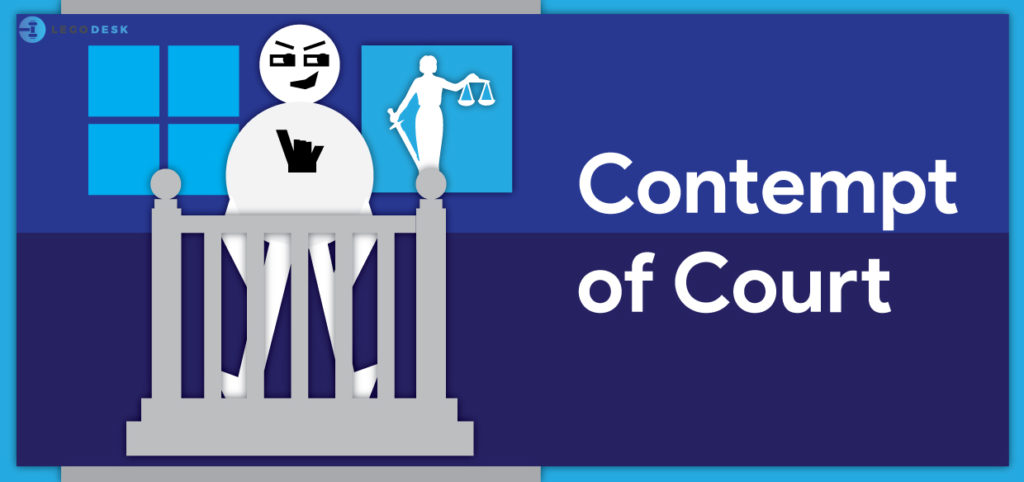Contempt of Court in India
What is Contempt of Court?
Anything that abridges or impedes the opportunity of cutoff points of the legal procedures should of need bring about hampering of the organization of Law and in meddling with the proper method of equity. Contempt of court is any conduct or bad behavior that contentions with or challenges the expert, trustworthiness, and prevalence of the court. These demonstrations may incorporate inability to follow demands, witness altering, retaining proof, an intrusion of procedures, or resisting court proceedings. These improper demonstrations might be submitted by lawyers, officers of the court, court faculty, attendants, witnesses, protesters, or any gathering engaged with a court continuing.
Contempt of Court can be of two sorts, common or criminal relying upon the idea of the case.
1. Civil Contempt
Under Section 2(b) of the Contempt of Courts Act of 1971, civil contempt has been defined as willful disobedience to any judgment, decree, direction, order, writ or other processes of a court or willful breach of an undertaking given to a court.
2. Criminal Contempt
Under Section 2(c) of the Contempt of Courts Act of 1971, criminal contempt has been defined as the publication (whether by words, spoken or written, or by signs, or by visible representation, or otherwise) of any matter or the doing of any other act whatsoever which:
(i) Scandalises or tends to scandalize, or lowers or tends to lower the authority of, any court, or
(ii) Prejudices, or interferes or tends to interfere with the due course of any judicial proceeding, or
(iii) Interferes or tends to interfere with, or obstructs or tends to obstruct, the administration of justice in any other manner
Punishment for the contempt of court
High Court and Supreme Court are offered with the ability to rebuff for the hatred of the court.
Under Section 12 of Contempt of Court Act, 1971, contempt of court can be rebuffed with straightforward detainment for a term which may reach out to a half year, or with fine which may stretch out to two thousand rupees, or with both.
Notwithstanding, in common cases if the court thinks about that a fine won’t meet the closures of equity and that a sentence of imprisonment is essential will, rather than condemning him to basic detainment, coordinate that he be kept in a common jail for such period not surpassing a half year as it might think fit.
The court should force a sentence for contempt of court in abundance of what is recommended under this section either in regard to itself or of a court subordinate to it.
A denounced might be released or the discipline granted might be transmitted on the expression of remorse being made by the blamed to the fulfillment for the court. An expression of remorse should be dismissed simply on the ground that it is qualified or restrictive if the denounced makes it genuine.
Resistances permitted in Contempt continuing
Condition (b) of Section 13 of Contempt of Court Act, 1971 that was presented as of late by 2006 alteration, enables the blamed to raise the guard for avocation by the truth of such disdain if the court is fulfilled that it is out in the open intrigue and the demand for conjuring the said protection is genuine.
In any case, no court will force a sentence under this Act for hatred of court except if it is fulfilled that the contempt is of such a nature, to the point that it generously meddles, or tends significantly to meddle with the proper way of equity.
Law Point
For the idea of Contempt of Court, the Contempt of Court Act, 1971 was passed which managed such an idea. Article 129 and 215 of the Constitution of India enables the Supreme Court and High Court separately to rebuff individuals for their particular hatred. Section 10 of The Contempt of Courts Act of 1971 characterizes the intensity of the High Court to rebuff disdains of its subordinate courts. Capacity to rebuff for hatred of court under Articles 129 and 215 isn’t liable to Article 19(1)(a).
Basics
The components by and large expected to build up a contempt are:
1. the creation of a substantial court arrange,
2. information of the request by the respondent,
3. capacity of the respondent to render consistency, and
4. willful rebellion of the request.
Types
As indicated by Lord Hardwick, there is a three-overlay order of Contempt:
1. Embarrassing the court itself.
2. Mishandling parties who are worried about the reason, within the sight of court.
3. Prejudicing general society before the reason is to hear.
CONCLUSION
It is important for the learned counsel or any other individual to respect the Hon’ble judges of the court of law and adhere to the proceedings of the court. Judiciary is the most respectable organ of the Government and hence, must be obeyed in every manner whatsoever. Any form of disregard for the court may be deemed as contempt of court.
Try our Debt Resolution solutions today Request a Demo
